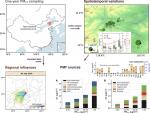摘要:
Carbonaceous aerosols are linked to severe haze and health effects, while its origins remain still unclear over China. PM2.5 samples covering four seasons from Jan. 2016 to Jan. 2017 were collected at six sites in Chifeng, a representative agro-pastoral transitional zone of North China focusing on the characteristics and sources of organic carbon (OC) and elemental carbon (EC). The annual averages of OC, EC were 9.00 ± 7.24 μg m−3, 1.06 ± 0.79 μg m−3 with site Songshan in coal mining region exhibited significantly enhanced levels. The residential heating emissions, air stagnation, and secondary organic formation all contributed the higher OC, EC levels in winter. Meanwhile, the impacts from open biomass burning were most intensive in spring. The retroplumes via Lagrangian model highlighted a strong seasonality of regional sources which had more impacts on EC increases. The Positive Matrix Factorization (PMF) model resolved six primary sources, namely, coal combustion, biomass burning, industrial processes, oil combustion, fugitive dust, and fireworks. Coal combustion and biomass burning comprised large fractions of OC (30.57%, 30.40%) and EC (23.26%, 38.47%) across the sites, while contributions of industrial processes and oil combustion clearly increased in the sites near industrial sources as smelters. PMF and EC tracer method gave well correlated (r=0.65) estimates of Secondary OC (SOC). The proportion of coal combustion and SOC were more enhanced along with PM2.5 elevation compared to other sources, suggesting their importances during the pollution events.
访问链接

